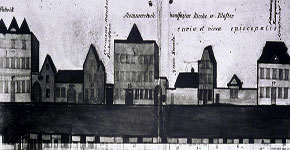
THE SOURCE AND ORIGIN OF THE CONGREGATION OF THE
CELLITINNEN LAY IN THE PIOUS LAY FEMALE MOVEMENT
(BEGINEN) OF 13TH AND 14TH CENTURIES
[Translation of an article found in the Souvenir published by our sisters on the occasion of the 125 year jubilee of the St. Joseph’s hospital at St. Vith, Belgium.]
Women's lives between cloister and world... The "cradle" of the lay women’s movement started in Liège, Belgium, could have come from the priest Lambert le Begues who donated the first Lay women’s’ House in 1180. The origin of the name Beguines is still unknown. Narratives connects it with the name of holy Begga of Herstal, who was raised in a later period as the patron of Begine houses, probably footing to a legend.
The desire for deeper spiritual life is felt everywhere in 12th century. The different forms of poverty movements (like that of St. Francis of Assissi) of High Middle Ages era encompasses people of all walks of life: clergy, laity, men and women. The reformed congregations or Orders of that time and the newly formed nunneries could no longer accommodate the growing number of women who desire for apostolic life. This background of economic motivations (surplus of women, poverty and lack of rights for women) and religious and-mystical drive supported women's movement and they gave a new style of life outside the walls.
Begines and their male counterpart the Begards are known in the historical sources of the 12th to 14th century as the members of Collegia Beguinarum, ie: religious communities that were between established orders and laity. They are known by different names: Beguines or Beguinae, also Beghardi, Beguini, Polternonnen, Seelschwestern, Lollards, cell brothers or Celliten.
The priest Lamberts le Begues built a considerable number of individual cottages in one large garden belonging to him near the city. Virgins and widows could live there without distinction of rank and possessions under one condition that the time they live there they have to voluntarily commit to poverty, chastity, obedience, prayer, fasting and the sacraments. In the span of few years number of such houses increased. Lambert le Begues died three years later, but his Begine houses grew rapidly in number in Lüttish, Netherlands, France and Germany.
In contrast to the nuns in the monasteries the Beguines were permitted to leave from the Community. They could take their assets, marry and lead a middle class life. For this reason, in the heydays of the Begines there lived only older women in the Begine houses. It became a fixed rule and sanctioned by papal bulls that an unmarried woman is not allowed to be a Beguine before she was 40 years old.
In their Beginenhof each community was sovereign and independent. They had a Madam in charge or a mistress who was one of their number, usually elected for one year. This initiative was regarded as the first secular association of pious women religious for practical purposes. They worked with the aim to improve the morally depraved social status of the women of the middle classes. They were engaged in nursing the sick, care for the orphans, care for the youth, in rescue works, education of minors, and the fallen women. Furthermore, the Beguines operated as women who would prepare the dead bodies or practiced the textile crafts. Although most Begines were wealthy, they were involved in charitable activities for their livelihood.
However, the Beguines were also devoted to prayer and contemplation. Therefore it is not surprising that from the community of Beguines emerged some known Mystics like Juliana of Liege. The origin of the feast of Corpus Christi is due to her proposal in 1246 in the diocese of Liege.
From the fourth Lateran Council in 1215 the creation of new spiritual communities was banned generally, so as to keep the reform movements manageable and avoid confusions due to so many religious groups. Nevertheless, the Beguines were given an oral approval a year later by Pope Honorius III, at the request of Jacques de Vitry that "religious-minded women" may live together and "mutually exhort to prayer". With this official papal blessing the Begines flourished greatly during the 13th and 14th century, with convents in most of Western Europe, especially in northern Italy, southern France, the Netherlands (including Flanders) Austria and Switzerland.
The beguines were organized in the church in Belgium. In 2004 there existed five active Beguines in Flanders (including in Kortrijk and Gent). The UNESCO inscribed half of the 26 existing Flander Beguinages, including in Bruges, in the list of world cultural heritage.
In Cologne, there was the Battle of Worringen in 1288. Although the temporal power of the archbishops were taken away, the church organization remained untouched by the defeat of Siegfried of Westerburg. The women were denied freedom and independence but for all who sought a spiritual task, there was an abundance of offers. Nevertheless, the Beguines grew in number about two thousand members in 1240. They had about 160 convents between five and thirty members. Favored with the Papal Bull of 12 February, 1453 many Beguines who work in the hospital setting communities accepted the Rule of St. Augustine. So also in Cologne, where the waiting sisters (Wartenonnen Nuns who waited on people, Home nurses) accepted the vows were called Cellitinnen. One of these converted into a convent of Cellitinnen to St. Elizabeth of Antonsgasse (now located in the Gleuler road), since 1312, while most other Cologne Cellitinnen convents were closed during the French revolution.



